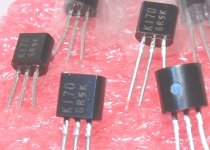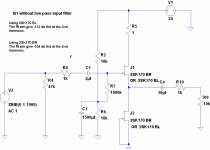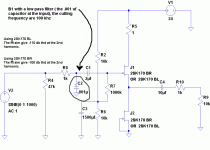Shoot them some clean macro pictures front & back, we will be able to advise if real Toshiba, and if they are valid save them for something else. For B1 get BL as Russellc wrote.
P.S. That's 11% error, don't trust the analyzer for any real IDSS matching in the future.
Realy able to advise if real Toshiba?
Do you can do this also for 2SJ109bl i have 4 dont know they are real ore not?
I have such to visually compare too. But better we take that to the sticky thread: http://www.diyaudio.com/forums/parts/82638-my-transistors-original-copy-47.html
Hi
Here is the photo of my 2SK170.
If it's not toshiba, could it be genuine 2SK170 from another maker ?
Thanx
Paul
Here is the photo of my 2SK170.
If it's not toshiba, could it be genuine 2SK170 from another maker ?
Thanx
Paul
Attachments
Last edited:
Hi
I've just look in a box of old amps boards and I found six 2SK170 on one amp board.
I have done again the IDSS test, using a 9 volt battery, and it have a IDSS of arround 5.3 ma for all those six 2SK170
They have a bit low IDSS, but can I use those 2SK170 for the B1 ?
Thanx
Paul
I've just look in a box of old amps boards and I found six 2SK170 on one amp board.
I have done again the IDSS test, using a 9 volt battery, and it have a IDSS of arround 5.3 ma for all those six 2SK170
They have a bit low IDSS, but can I use those 2SK170 for the B1 ?
Thanx
Paul
Hi
Here is the photo of my 2SK170.
If it's not toshiba, could it be genuine 2SK170 from another maker ?
Thanx
Paul
They look Toshiba.
Hi
And how about the six 2SK170 I found on one amp board, they have a IDSS of arround 5.3 ma, can they be ok for the B1 ?
Thanx
Paul
And how about the six 2SK170 I found on one amp board, they have a IDSS of arround 5.3 ma, can they be ok for the B1 ?
Thanx
Paul
Hi
I've just look in a box of old amps boards and I found six 2SK170 on one amp board.
I have done again the IDSS test, using a 9 volt battery, and it have a IDSS of arround 5.3 ma for all those six 2SK170
They have a bit low IDSS, but can I use those 2SK170 for the B1 ?
Thanx
Paul
If they are GR then that IDSS is in range. If they are marked BL then that IDSS tells they are wrong parts.
5.3mA is for Yfs ~30 which is not low in general although a 9mA BL gets you to ~40. That figure is the "amplifying might" of the part. In B1 all this is utilized as current drive, the more its got the less THD and output impedance it presents, but bit more input capacitance. And more IDSS that goes with the territory ups the TO-92 cased JFET's heat dissipation too. B1 was designed around BL grade, 8-9mA is a good compromise. V grade would need a cooling aid without giving analogous gain in might because the Yfs curve tappers off as it ascends its scale. All in all, its you compromise by a margin if going with GR but you still got a B1. Although on the somewhat weaker performance side.
Hi
I've look and those six 2SK170 are GR grade.
So with those jfet I would have much more thd in my B1 ?
Thanx
Paul
I've look and those six 2SK170 are GR grade.
So with those jfet I would have much more thd in my B1 ?
Thanx
Paul
Last edited:
P.S. If you can't find very good matches because just six, use the lesser IDSS one in a channel pair as the one with g,s pins going together in same node.
Hi
How much close we need to match jfet to put two in parallel in the B1 circuit ?
Thanx
Paul
How much close we need to match jfet to put two in parallel in the B1 circuit ?
Thanx
Paul
Last edited:
Don't do it, its not a proper B1.
P.S. IDSS is only indicative of Vgs(off), Yfs, those are not exact in each die for even same ID. And then you got two different housings trying to follow in each position each other thermally and double the Ciss making it slower, leads and traces... no cigar, no real B1, you lose much more than in a GR B1.
P.S. IDSS is only indicative of Vgs(off), Yfs, those are not exact in each die for even same ID. And then you got two different housings trying to follow in each position each other thermally and double the Ciss making it slower, leads and traces... no cigar, no real B1, you lose much more than in a GR B1.
Hi
Ok, no paralleling.
But anybody know how much more thd wen using 2SK170 with only 5 ma IDSS in the B1 ?
Thanx
Paul
Ok, no paralleling.
But anybody know how much more thd wen using 2SK170 with only 5 ma IDSS in the B1 ?
Thanx
Paul
Depends on signal level a lot too. Someone has got to make or simulate GR and BL B1 then FFT from min to max level so to speak in numbers.
Hi
I use Ltspice but the 2SK170 model do have a IDSS of 10ma
.model J2sk170 NJF(Beta=59.86m Rs=4.151 Rd=4.151 Betatce=-.5 Lambda=1.923m Vto=-.5024 Vtotc=-2.5m Cgd=20p M=.3805 Pb=.4746 Fc=.5 Cgs=25.48p Isr=84.77p Nr=2 Is=8.477p N=1 Xti=3 Alpha=10u Vk=100 Kf=111.3E-18 Af=1)
How can we change this model IDSS to 5 ma ?
Thanx
Paul
I use Ltspice but the 2SK170 model do have a IDSS of 10ma
.model J2sk170 NJF(Beta=59.86m Rs=4.151 Rd=4.151 Betatce=-.5 Lambda=1.923m Vto=-.5024 Vtotc=-2.5m Cgd=20p M=.3805 Pb=.4746 Fc=.5 Cgs=25.48p Isr=84.77p Nr=2 Is=8.477p N=1 Xti=3 Alpha=10u Vk=100 Kf=111.3E-18 Af=1)
How can we change this model IDSS to 5 ma ?
Thanx
Paul
Lower Beta to 30m then Vto, until you will see 5mA for a k170 g,s shorted to gnd off a 9VDC source.
Hi
Here is the new model for the 2SK170-GR, it have a IDSS of 5.04 ma. with a
9 volt dc source.
.model J2sk170gr NJF(Beta=30m Rs=4.151 Rd=4.151 Betatce=-.5 Lambda=1.923m Vto=-.4274 Vtotc=-2.5m Cgd=20p M=.3805 Pb=.4746 Fc=.5 Cgs=25.48p Isr=84.77p Nr=2 Is=8.477p N=1 Xti=3 Alpha=10u Vk=100 Kf=111.3E-18 Af=1)
Thanx
Paul
Here is the new model for the 2SK170-GR, it have a IDSS of 5.04 ma. with a
9 volt dc source.
.model J2sk170gr NJF(Beta=30m Rs=4.151 Rd=4.151 Betatce=-.5 Lambda=1.923m Vto=-.4274 Vtotc=-2.5m Cgd=20p M=.3805 Pb=.4746 Fc=.5 Cgs=25.48p Isr=84.77p Nr=2 Is=8.477p N=1 Xti=3 Alpha=10u Vk=100 Kf=111.3E-18 Af=1)
Thanx
Paul
Last edited:
Hi
I've done Ltspice simulation of the B1 using those two model to compare.
The BL type of 2sk170:
.MODEL 2sk170 NJF (VTO=-5.211e-001 BETA=3.683e-002 LAMBDA=4.829e-003 IS=1.000e-009, RD=0.000e+000 RS=0.000e+000 CGS=5.647e-011 CGD=2.562e-011 PB=4.860e+000 FC=0.5)
The BR type of 2sk170:
.MODEL 2sk170b NJF (VTO=-4.911e-001 BETA=1.983e-002 LAMBDA=4.829e-003 IS=1.000e-009, RD=0.000e+000 RS=0.000e+000 CGS=5.647e-011 CGD=2.562e-011 PB=4.860e+000 FC=0.5)
I simulated with a 1 volt 1 khz signal at the B1 circuit input.
Adding a low pass filter capacitor at the input did cut a lot the thd of the BR type of 2sk170.
Thanx
Paul
I've done Ltspice simulation of the B1 using those two model to compare.
The BL type of 2sk170:
.MODEL 2sk170 NJF (VTO=-5.211e-001 BETA=3.683e-002 LAMBDA=4.829e-003 IS=1.000e-009, RD=0.000e+000 RS=0.000e+000 CGS=5.647e-011 CGD=2.562e-011 PB=4.860e+000 FC=0.5)
The BR type of 2sk170:
.MODEL 2sk170b NJF (VTO=-4.911e-001 BETA=1.983e-002 LAMBDA=4.829e-003 IS=1.000e-009, RD=0.000e+000 RS=0.000e+000 CGS=5.647e-011 CGD=2.562e-011 PB=4.860e+000 FC=0.5)
I simulated with a 1 volt 1 khz signal at the B1 circuit input.
Adding a low pass filter capacitor at the input did cut a lot the thd of the BR type of 2sk170.
Thanx
Paul
Attachments
Last edited:
- Home
- Amplifiers
- Pass Labs
- B1 Buffer Preamp


